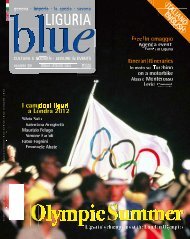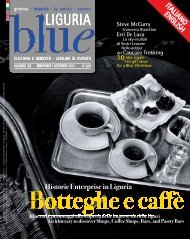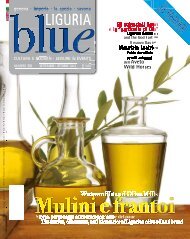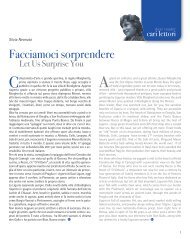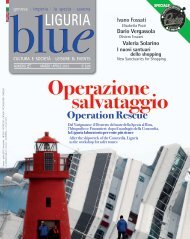Create successful ePaper yourself
Turn your PDF publications into a flip-book with our unique Google optimized e-Paper software.
lue <strong>cover</strong><br />
I porticcioli più vicini<br />
The Closest Harbors<br />
Marina Genova Aeroporto<br />
posti barca/mooring spot: 500<br />
Lunghezza massima scafo/max<br />
hull length: 90 metri<br />
Hospitality Desk tel. 010 6143420<br />
www.marinagenova.it<br />
info@marinagenova.it<br />
Genovaa Sestri Bocca di<br />
Ponente<br />
posti barca/mooring spot: 1180<br />
Lunghezza massima scafo/max<br />
hull length: 38 metri<br />
Approdi vicini: Porto Vecchio di<br />
Genova<br />
Cantieri Navali Sestri<br />
tel. 010 6512476<br />
genova@guardiacostiera.it<br />
Genova Marina Porto Antico<br />
posti barca/mooring spot: 270<br />
Lunghezza massima scafo/max<br />
hull length: 70 metri<br />
tel. 010 2470039-256587<br />
www.marinaportoantico.itporto<br />
@marinaportoantico.it<br />
mpa@marinaportoantico.it<br />
Genova Marina Molo Vecchio<br />
posti barca/mooring spot: 160<br />
Lunghezza massima scafo/max<br />
hull length: 90 metri<br />
tel. 010 27011<br />
www.mmv.it - mmv@mmv.it<br />
Genova Duca degli Abruzzi<br />
posti barca/mooring spot: 380<br />
Lunghezza massima scafo/max<br />
hull length: 25 metri<br />
Yacht Club Italiano tel. 010<br />
2461206<br />
genova@guardiacostiera.it<br />
Marina Fiera di Genova<br />
posti barca/mooring spot: 305<br />
Lunghezza massima scafo/max<br />
hull length: 25 metri<br />
MA.RI.NA Service Genova<br />
tel. 010 580760<br />
porto@marina-service.it<br />
info@marina-service.it<br />
Camogli (Ge)<br />
posti barca/mooring spot: 200<br />
Lunghezza massima scafo/max<br />
hull length: 10 metri<br />
Approdi vicini/docking spots:<br />
Golfo Paradiso<br />
Capitaneria di Porto<br />
tel. 0185 770032<br />
70<br />
Alla realizzazione dell’acquedotto, attivo fino al<br />
1917 quando un decreto dichiarò “la non potabilità”<br />
delle sue acque, contribuirono i più grandi<br />
architetti e ingegneri genovesi: Storace, Aicardo,<br />
Vinzoni, Bianco, Bagliani e Barabino, gli<br />
stessi che hanno edificato palazzi e monumenti<br />
cittadini. “Bisogna ricordare anche il lavoro di<br />
muratori, manovali, piccapietra, cavatori e riparatori<br />
di frane, che resero possibile l’opera. L’acquedotto,<br />
abbandonato nel 1957, è stato, per un<br />
millennio, la seconda grande fabbrica genovese<br />
dopo il porto”, spiega Giordano Bruschi che con<br />
Valter Lattanzi e Giusi Giani dal 2005 animano il<br />
Circolo di via Sertoli, il cui scopo è la gestione e<br />
il recupero dell’acquedotto.<br />
L’intero tracciato è lungo una quarantina di km<br />
(derivazioni comprese) e potrebbe essere una<br />
meravigliosa “creuza verde” che attraversando<br />
orti, prati e torrenti giunge in piazza Caricamento,<br />
dove sono restate le trecentesche arcate<br />
di Sottoripa.<br />
Il percorso in città<br />
Fino al XVII sec. l’acquedotto entrava in città dall’attuale<br />
via Burlando per poi giungere a Castelletto<br />
dove scendeva a Porta dei Vacca e qui si divideva<br />
in due rami, uno andava verso ponente e<br />
finiva in Darsena, l’altro nella cisterna del Molo.<br />
Successivamente furono costruiti altri bracci affinché<br />
tutta la città fosse servita. Dopo l’espan-<br />
1917, when a decree declared that its waters were<br />
no longer “drinkable” – some of Genoa’s greatest<br />
architects and engineers contributed their input.<br />
Storace, Aicardo, Vinzoni, Bianco, Bagliani, and<br />
Barabino, the same designers of buildings and of<br />
public monuments worked along with bricklayers,<br />
masons, manual workers, stone workers, excavators,<br />
landslide experts, to make it all possible. “The<br />
aqueduct, abandoned in 1957, was for one<br />
thousand years the second greatest Genoese<br />
employer after the port,” explains Giordano Bruschi,<br />
who with Valter Lattanzi and Giusi Giani in 2005<br />
created the club, the Circolo di Via Sertoli, whose<br />
mission is the management and the re<strong>cover</strong>y of the<br />
aqueduct. Its entire route, being around forty km<br />
long (including derivations), would make it a<br />
marvelous “green alleyway” which crosses gardens,<br />
meadows and streams to reach the port in Piazza<br />
Caricamento, by what remains of the 14 th century<br />
arches of Sottoripa.<br />
Its Route in the City<br />
Until the XVII century, the aqueduct entered the city<br />
along Via Burlando to reach the quarter of Castelletto<br />
where it came down to the sea at the city gate of<br />
Porta dei Vacca. Here it divided in two, one branch<br />
heading west to the pier area, the Darsena, the other<br />
reaching the cistern at Molo. Later other branches<br />
were built, until the whole city was serviced. After the<br />
urban expansion of the last few centuries, few traces



